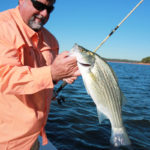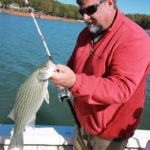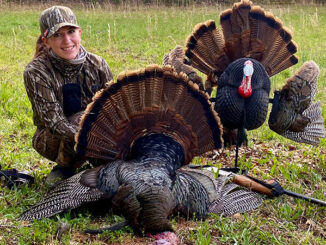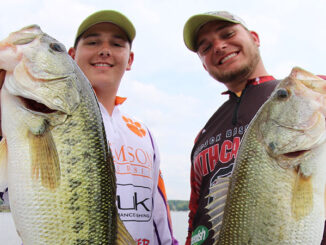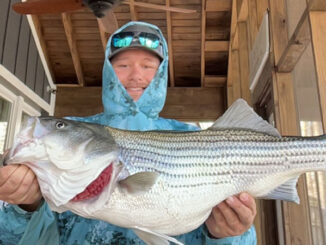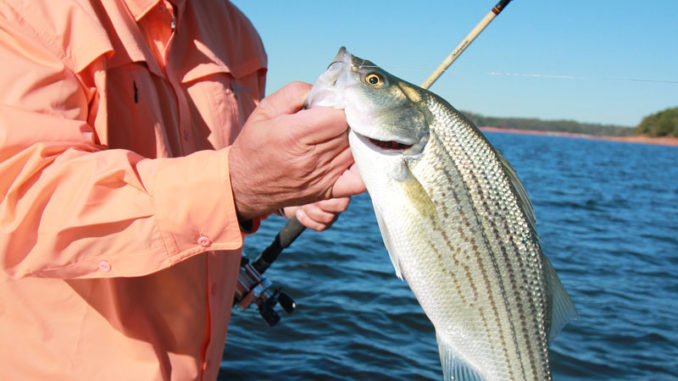
When blueback herring spawn on Lake Hartwell this month, stripers and hybrid bass will pile into the shallows on red-clay banks to gorge themselves. Be there when you get there, and you’ve got some fast action at hand.
It is nighttime — the crack of dawn is still and hour or more away — and South Carolina’s Lake Hartwell is dark. Chip Hamilton points the bow of his striper boat straight at the bank of a point jutting out into the lake and revs the engine briefly to drive the front of the boat up on the bank.
There are no boat lights nor any lights rigged to shine on the water near the boat, but Hamilton uses a small light in the boat to start baiting Carolina rigs with live blueback herring. One by one, four baits are cast out the back and off the sides of the boat. If the fish are there, the first rod will have a fish on before the fourth bait hits the water.
It’s spring and that means it is striper/hybrid bonanza time on Hartwell, the sprawling reservoir on the Savannah River along the South Carolina-Georgia border.
By dawn’s early light, the feeding frenzy is beginning to wind down, but on a good day, that’s fine, because the cooler is filled with limits of stripers and hybrids — and on a really good day there will be a bonus of nice spotted bass and largemouth bass in the mixture.
“If you can get on a point where the fish are stacked up, a four-person limit of 40 fish is not a problem,” said Hamilton, who runs Lake Hartwell Fishing Charters. “This kind of fishing can start as early as March, and I have seen it go all the way to the end of May and the first of June. Usually, it is wrapped up by the middle of May, but it will go into June if the water temperature has not gotten too hot.”
The feeding frenzy starts to kick in, he said, when the water temperature hits the 60- to 62-degree mark and holds on until it gets into the low 70s.
“Once the water temperature gets into the 70s, that’s when it begins to phase out,” Hamilton said.
Red-clay banks are key for this bonanza, and there are two phases, he said.
“The first time we do it is when the fish are doing a false spawn,” he said. “They will be up on the banks, and when you put a bait in front of them, they will readily take it. The second phase is when the baitfish, especially blueback herring, spawn. The fish move up onto the banks to eat them.”
Hamilton prefers gently sloping, red-clay banks on points jutting out into the lake near deep water.
“I have caught them on rocky points and sandy points, but if I fish 10 points, at least eight of them will be red clay, and Hartwell is full of red clay,” he said.
“The water your bait is in can be as shallow as 18 inches or even 4 feet deep, but not super deep. You want your rods sitting in about 2 to 4 feet with a decent cast. If you are on a deep point, that’s not good and if you are on a long, sloping point that is not good.”
The ideal place to set up, he said, is a point where the water level goes out to just shy of 20 feet before it drops off into deeper water.
“That is the best situation,” he said. “The fish patrol at 12 to 14 feet. When they see the bait up there near the bank, they ease up there and get it.”
In fact, Hamilton said, there is no need to match the bait to the baitfish this time of year. Most of the baitfish are blueback herring, but smaller threadfin shad may be spawning up the creeks.
“If you are upriver and they are feeding on the smaller threadfins and you throw a 5- to 6-inch herring out there, they will eat it,” he said. “The size of the bait doesn’t matter that much; they are just ready to eat this time of year.”
The basic rig for this type of fishing is a Carolina rig with an egg sinker and a 2-foot leader.
“The egg sinker hits the bottom, and the bait can swim around the sinker,” he said. “If you cast it out into 2 feet of water, the bait can make it to the surface. All of a sudden, you hear the same sound when fish are schooling and one blows up on the bait. You know he ran that bait all the way to the end of the leader and got it. It’s a real adrenaline rush to hear that and feel the rod bend with a hostile hybrid.”
But the bank-bite feeding frenzy only lasts as long at darkness reigns, he said.
“The reason is because Hartwell is so clear for the most part. The sun makes them move out to deeper water for comfort and safety,” said Hamilton, who believes some of the best action is just before the move. “A lot of times at the crack of daylight, they know the bait is ready to leave the bank, so they just absolutely gorge themselves. They know the easy feeding is about over.,
“When the daylight is strong enough to turn off the light in the boat, you have about 20 more minutes to fish the bank. I will give it an extra 15 or 20 minutes to see if a big striper comes by in search of a quick meal. Many times, I’ve had some nice stripers come in right at daylight, 12- to 15-pound stripers, occasionally a 20-pounder.”
A heavy, overcast sky or even a little misty rain can prolong the bank bite a bit, Hamilton said, but eventually it will be over and he will back off to fish free-lines over a nearby ditch or pocket if his party has not already limited out.
The only way to describe the bank bite when the fish are in a feeding frenzy is “chaos,” Hamilton said.
“The hybrids will be 2 to 3 pounds up to 8 or 9 pounds,” he said. “A big hybrid is a real job up on the bank. It’s harder to fight the fish on the bank versus straight down in deeper water because he is able to do more sideways fighting. But that is good for the customer; it’s all about the fight.”
It can be really chaotic when everybody on the boat is fighting a fish in that shallow water, he noted.
“On some of my more-exciting trips, we have had four fish on at a time,” Hamilton said. “You just cast the rod out, turn the reel handle and hand it to the customer. If the fish are there, you just set the hook.”
The pattern can be pretty consistent while the herring are spawning and hybrids and stripers are gorging in the shallow water, Hamilton said.
“If they are there one day, they will be there the next day — or not far from that spot,” he said. “One spring, I fished one point, sitting in the same direction each day, and caught a limit for everyone on the boat for 13 trips in a row. That was several hundred hybrids just sitting in the same spot every morning.”
DESTINATION INFORMATION
HOW TO GET THERE — Lake Hartwell straddles the border between Georgia and South Carolina on the Savannah, Tugaloo and Seneca rivers. The best access is via I-85 to areas around Clemson and Anderson. The U.S. Army Corps of Engineers, local governments, South Carolina and Georgia maintain boating facilities around the lake. For information visit: http://www.sas.usace.army.mil/About/Divisions-and-Offices/Operations-Division/Hartwell-Dam-and-Lake/Plan-A-Visit/Boating/
WHEN TO GO — Depending on water temperatures the annual herring spawn, which triggers the striper/hybrid feeding frenzy along the banks, can begin in late March and last through late May, sometimes into early June.
BEST TECHNIQUES — Well before the first crack of dawn, run your boat up onto a red-clay bank to stabilize it, then cast live blueback herring on Carolina rigs behind and off the sides of the boat in less than 4 feet of water. If the bite is slow, move to another red-clay bank.
FISHING INFO/GUIDES — Chip Hamilton, Lake Hartwell Fishing Charters, www.lakehartwellfishingcharters.com, 864-304-9011. See also Guides and Charters in Classifieds.
ACCOMMODATIONS — Lake Hartwell Country, www.crownofthecarolinas.org/where-to-stay; Anderson Convention and Visitors Bureau, www.visitanderson.com/Lake-Hartwell;
MAPS — Kingfisher Maps, 800-326-0257, www.kfmaps.com.

